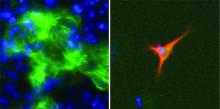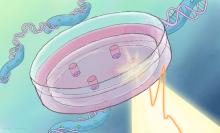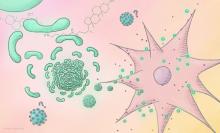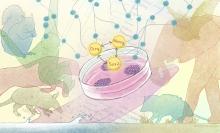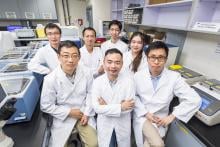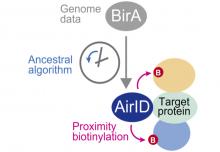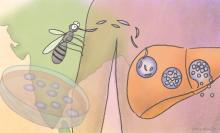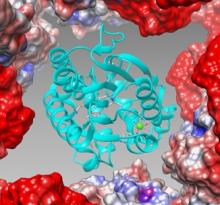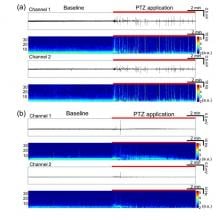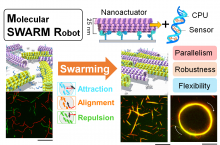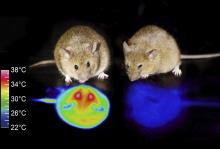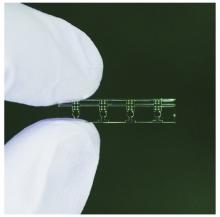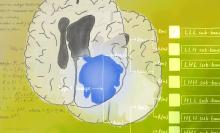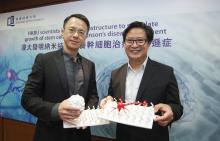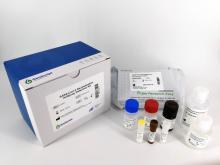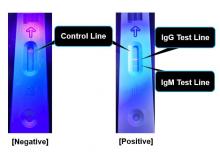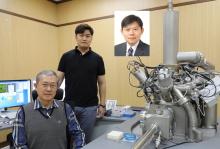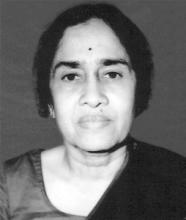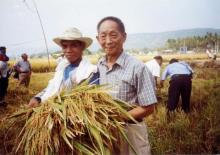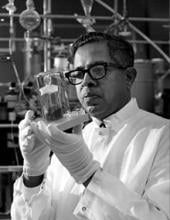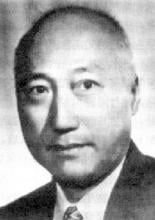Biotech
News
03 Oct 2020
A new apparatus improves how we study the effects of aiming high-field terahertz radiation at cells, with implications for regenerative medicine.
01 Oct 2020
Scientists have found an ingredient that makes a vaccine more effective through an approach more often seen in materials science – testing molecules that self-assemble into larger structures.
11 Sep 2020
Measuring the temperature of objects at a nanometer-scale has been a long challenge, especially in living biological samples, because of the lack of precise and reliable nanothermometers. An international team of researchers has realized a quantum technology to probe temperature on a nanometer-scale, and have observed a ‘fever’ in tiny nematode worms under pharmacological treatment. This strengthens the connection between quantum sensing and biology and ushers in novel thermal imaging technologies in biomedical research.
07 Sep 2020
Scientists are learning about species adaptation by comparing their stem cell-related genes.
17 Aug 2020
Duke-NUS spinout, PairX, led by US and Singapore scientists and investors, to advance immunotherapy biotech exclusively licensed from Duke-NUS.

12 Aug 2020
Researchers in China have taken the first step towards a new way of treating gastric wounds by using a microrobot combined with the new concept of “in situ in vivo bioprinting” to carry out tissue repair inside the body.
24 Jul 2020
While scientists still don’t fully understand the diverse nature of RNA molecules, it is believed that the proteins binding to them, called RNA-binding proteins, are associated with many disease formation. A research led by biomedical scientists from City University of Hong Kong (CityU) has developed a novel detection method, called CARPID, to identify binding proteins of specific RNAs in the living cells. It is expected the innovation can be applied in various cell research, from identifying biomarkers of cancer diagnosis to detecting potential drug targets for treating viral diseases.

23 Jul 2020
A simple, rapid assay to evaluate neutralizing antibodies that target the SARS-CoV-2 spike protein receptor binding domain (RBD) is described in a paper published in Nature Biotechnology.
10 Jul 2020
Scientists demonstrate that the information about host bacteria–bacteriophage (phage) associations derived from world’s first metagenome analysis is useful for the development of phage therapies against intestinal pathobionts.
06 Jul 2020
Proteins play roles by interacting with various other proteins. Therefore, interaction analysis is an indispensable technique for studying the function of proteins. In this research, we have developed a biotinylation enzyme, AirID, using an ancestral enzyme reconstruction algorithm. AirID is a highly active biotinylation enzyme with low toxicity. By using AirID, comprehensive biotinylation of proteins interacting with a target protein in cells was achieved when the target protein was expressed as a fusion protein with AirID.
02 Jul 2020
A method that involves infecting liver cells with mosquito-bred parasites could improve the study of malaria in India.
30 Jun 2020
Hiroshima University scientists will work on a low-cost sex selection system for bovines using their new technology to help grow dairy herds and boost the incomes of India’s smallholder farmers.
29 Jun 2020
A research team from the School of Life Sciences at The Chinese University of Hong Kong (CUHK) has developed a novel method for extracting enzymes from bacteria, which lowers the production cost yet improves the enzyme’s stability. It also opens up a new avenue for the enzymatic production of biodiesel, an eco-friendly and effective substitute for fossil fuels. The research findings were recently published in the Journal of the American Chemical Society.
29 Jun 2020
Novel system for simultaneously measuring brain electrical signals from multiple zebrafish opens up path to cheaper and faster drug screening for neurological disorders
18 Jun 2020
Scientists are looking for ways to make millions of molecule-sized robots swarm together so they can perform multiple tasks simultaneously.
12 Jun 2020
Researchers at the University of Tsukuba and RIKEN in Japan spark a hibernation-like state in mice—a species that does not naturally hibernate
09 Jun 2020
A transparent container made by Nagoya University researchers allows easy and quick grafting of very young plants, with benefits for agriculture and plant research.
03 Jun 2020
A highly accurate machine learning tool could help doctors tailor individualized treatments for people with glioma brain tumours.
03 Jun 2020
Researchers from Hong Kong Baptist University (HKBU) have invented a nanostructure that can stimulate neural stem cells to differentiate into nerve cells. They found that the transplantation of these nerve cells into rats with Parkinson's disease progressively improved their symptoms, with the new cells replacing damaged nerve cells around the transplantation site. This novel invention provides promising insights into stem cell therapies and offers hope of a new treatment for Parkinson's disease.
27 May 2020
Scientists could gain insight into atypical sex development in vertebrates, including humans, by studying how nutrition affects sex changes in fish larvae.
15 May 2020
As a first-in-the-world "rapid smart test kit", the cPass™ which can measure neutralising antibodies in an hour will be a huge boost to current COVID-19 investigations, from contact tracing, sero-prevalence survey, and assessment of herd immunity, longevity of protective immunity and efficacy of different vaccine candidates.
15 May 2020
The newly developed rapid testing kit detects COVID-19 antibodies, requiring only micro-liter volume of serum and 15 minutes of time for achieving results.
12 May 2020
Researchers from Daegu Gyeongbuk Institute of Science and Technology(DGIST) have developed an innovative method that allows them to visualize up to tens of different proteins simultaneously in the same cell. This technology could help scientists elucidate the complex protein interactions involved in degenerative diseases such as Alzheimer’s, deepening our understanding of their mechanisms and allowing for early detection and treatment.

25 Mar 2020
Singapore's National Supercomputing Centre fast track access for researchers involved in COVID-19 research. Applications are open from now until 23 September 2020.
24 Mar 2020
A new approach could lead to “cornea-on-a-chip” devices that more accurately test the effects of drugs on the human eye.
19 Mar 2020
Environmental changes trigger tiny RNA segments to modify plant pores involved in photosynthesis.
25 Feb 2020
Mayor Cheol-ho Song (Ulsan, South Korea) visited the startup facilities of Ulsan National Institute of Science and Technology (UNIST) on January 4, 2020.
23 Feb 2020
South Korea's Ulsan National Institute of Science and Technology (UNIST), in collaboration with POSTECH, have developed a new biomimetic ‘moving’ surface, inspired from the biomachanics of the pectoral fins of the Batoidea.
20 Feb 2020
A faculty startup, based at South Korea's Ulsan National Institute of Science and Technology (UNIST) has attracted 7 Billion KRW investment.
Events
Sorry, no events coming up for this topic.
Researchers
Sorry, no researchers coming up for this topic.
Giants in history
Pakistani botanist Azra Quraishi (22 September 1945 – 22 November 2002) is recognised for developing virus-free seed potatoes that increased potato production in Pakistan by an estimated five per cent.
Indian botanist Shipra Guha-Mukherjee (13 July 1938 – 15 September 2007) made a breakthrough discovery that enabled the genetic study of plants and, by extension, the development of improved varieties of rice, wheat, potatoes, and other crops.
Japanese chemist Takamine Jokichi (3 November 1854 – 22 July 1922) founded the Tokyo Artificial Fertilizer Company, where he isolated a starch-digesting enzyme (named takadiastase) from the fungus Aspergillus oryzae.
Filipina chemist María Orosa (29 November 1892–13 February 1945) fought malnutrition and food insecurity in the Philippines by devising over 700 culinary creations including Soyalac, a nutrient rich drink made from soybeans, and Darak, rice cookies packed with Vitamin B1, which could prevent beriberi disease caused by Vitamin B1 deficiency. She was also a partisan of the guerrilla movement resisting Japanese occupation during World War II, and died after being struck by shrapnel while working in her laboratory during the Battle of Manila.
Chinese biochemist Cao Tianqin (5 December 1920 – 8 January 1995) discovered the myosin light chain, a subunit of myosin, a protein crucial for muscle contraction.
In 1939, biochemist Kamala Sohonie (18 June 1911 – 28 June 1998) became the first woman to be accepted into the Indian Institute of Science (IISc).
Chinese agronomist Yuan Longping (7 September 1930 – 22 May 2021) developed the first varieties of the high-yield, hybrid rice that brought food security to multiple countries including China, which had been ravaged by food shortages as recently as the mid-20th century.
David T. Wong (born 1936) is a Hong Kong-born American neuroscientist who is best known for discovering the antidepressant drug fluoxetine, better known as Prozac.
Cyril Andrew Ponnamperuma (16 October 1923 – 20 December 1994) was a Sri Lankan chemist who was interested in the origins of life on Earth. His research in chemical evolution showed how inanimate molecules may have given rise to the building blocks of life – a process known as abiogenesis.
Osamu Shimomura (27 August 1928 – 19 October 2018) was a Japanese organic chemist and marine biologist who dedicated his career to understanding how organisms emitted light.
Janaki Ammal Edavalath Kakkat (4 November 1897 – 7 February 1984) was an Indian botanist who studied plant chromosomes and genetics.
Gopalasamudram Narayanan Ramachandran (8 October 1922 – 7 April 2001) is best known for developing the Ramachandran plot to understand the structure of short chains of amino acids, known as peptides.
Hsien Wu (24 November 1893 – 8 August 1959) is widely regarded as the founder of biochemistry and nutrition science in China. He was the first to propose that protein denaturation was caused by the unfolding of the protein, instead of chemical alteration.
Umetaro Suzuki (7 April 1874 – 20 September 1943) was a Japanese scientist best remembered for his research on beriberi, a disease caused by vitamin B1 deficiency, characterized by limb stiffness, paralysis and pain.
Maqsudul Alam (14 December 1954 – 20 December 2014) was a biologist from Bangladesh who is renowned for his research on genome sequencing
Barry Paw (29 August 1962 – 28 December 2017) was a biologist and oncologist who discovered several novel genes and their functions in red blood cells.
Gloria Lim (1930-2022) was a mycologist from Singapore who studied tropical fungi. One of the first students to attend University of Malaya when it was founded in 1949, she went on to become the first female Dean of the Faculty of Science at the University of Singapore.


